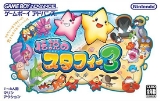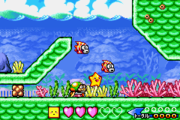
Densetsu no Stafy 3
Encyclopedia
is a platforming video game developed by TOSE
and published by Nintendo
for the Nintendo Game Boy Advance only in Japan
on August 5, 2004. It is the third game in the The Legendary Starfy series, as well as the third and last title of the series ever developed and released for the Game Boy Advance. Later, its sequel, Densetsu no Stafy 4, was developed for the Nintendo DS
.
s storyline, everything was calm and everyone, including the protagonist Stafy, known as Starfy in Western regions, was happy again, until another severe thunderstorm
came and shook Pufftop Palace. This time, it was more severe than the ones in the past. A lightning struck the Magic Jar and destroyed it, while the antagonist of the previous titles, Ogura, was free again. He later flew away from Pufftop Palace, while everyone else there wondered what he was leaving for. Starfy's father told Starfy and Moe to pursue Ogura, while Moe refused to do so and got mad, because he got bored of doing the same things they did in the past. Later, the sister of Starfy known as Starly, jumped and bounced on Moe, while she introduced herself to him. She later pushed him and her brother off the edge of Pufftop Palace and jumped down with them to pursue Ogura.
 Like its prequels, Densetsu no Stafy 3 plays very much like other platforming games, such as some Super Mario Bros. titles and some Kirby titles
Like its prequels, Densetsu no Stafy 3 plays very much like other platforming games, such as some Super Mario Bros. titles and some Kirby titles
, but it's mostly about swimming around stages, which makes this series' official game genre as marine platform. In fact, the colorful graphics and level layouts (as well as the look of Stafy) have drawn many comparisons to the Kirby series. Stafy himself can run, jump, and attack via spinning; he also gains access to various transportation objects and animal familiars as the games progress. Like Densetsu no Stafy 2 and unlike the first title of the series
, Densetsu no Stafy 3 usually has a certain number of stages per area, with each stage split up into four sub-stages. Most of the other stages' goals are centered around retrieving a lost or stolen item for another character. There are many items to collect and many enemies to defeat. You can move Starfy on land by running and jumping, but when Starfy is in watery areas, you can move him much more freely, make him push obstacles, and so on. Like its prequels, this game also includes minigames, except all of them are different compared to the ones that are similar to Atari
's Breakout.
, Nintendo and TOSE immediately moved on to develop Densetsu no Stafy 3. It took less than a year for Nintendo and TOSE to develop and release it. This time, the game was made with some features that the previous games didn't have, like multiplayer minigames for example. However, like its predecessors, Nintendo and TOSE aired animated television commercials for Densetsu no Stafy 3, as well as releasing some promotional merchandise. Perfume
, a J-Pop
group, recorded and played their own version of The Legendary Starfy main theme during the credits of a Japanese television show Oha-Sta
. Despite that being made, it wasn't released in retail stores.
gave the game a total score of 31 out of 40.
TOSE
is a video game development company based in Kyoto, Japan. It is most known for developing Nintendo's Game & Watch Gallery series, various Dragon Ball games, as well as other Nintendo products...
and published by Nintendo
Nintendo
is a multinational corporation located in Kyoto, Japan. Founded on September 23, 1889 by Fusajiro Yamauchi, it produced handmade hanafuda cards. By 1963, the company had tried several small niche businesses, such as a cab company and a love hotel....
for the Nintendo Game Boy Advance only in Japan
Japan
Japan is an island nation in East Asia. Located in the Pacific Ocean, it lies to the east of the Sea of Japan, China, North Korea, South Korea and Russia, stretching from the Sea of Okhotsk in the north to the East China Sea and Taiwan in the south...
on August 5, 2004. It is the third game in the The Legendary Starfy series, as well as the third and last title of the series ever developed and released for the Game Boy Advance. Later, its sequel, Densetsu no Stafy 4, was developed for the Nintendo DS
Nintendo DS
The is a portable game console produced by Nintendo, first released on November 21, 2004. A distinctive feature of the system is the presence of two separate LCD screens, the lower of which is a touchscreen, encompassed within a clamshell design, similar to the Game Boy Advance SP...
.
Plot
In the beginning, a short time after Densetsu no Stafy 2Densetsu no Stafy 2
is a platform video game developed by TOSE and published by Nintendo for the Nintendo Game Boy Advance in Japan on September 5, 2003. It is the second game in the The Legendary Starfy series.- Plot :...
s storyline, everything was calm and everyone, including the protagonist Stafy, known as Starfy in Western regions, was happy again, until another severe thunderstorm
Thunderstorm
A thunderstorm, also known as an electrical storm, a lightning storm, thundershower or simply a storm is a form of weather characterized by the presence of lightning and its acoustic effect on the Earth's atmosphere known as thunder. The meteorologically assigned cloud type associated with the...
came and shook Pufftop Palace. This time, it was more severe than the ones in the past. A lightning struck the Magic Jar and destroyed it, while the antagonist of the previous titles, Ogura, was free again. He later flew away from Pufftop Palace, while everyone else there wondered what he was leaving for. Starfy's father told Starfy and Moe to pursue Ogura, while Moe refused to do so and got mad, because he got bored of doing the same things they did in the past. Later, the sister of Starfy known as Starly, jumped and bounced on Moe, while she introduced herself to him. She later pushed him and her brother off the edge of Pufftop Palace and jumped down with them to pursue Ogura.
Gameplay

Kirby (series)
The series is a fantasy video game series developed by HAL Laboratory and Nintendo, and produced by Nintendo. The gameplay of a majority of the games in the series consists mainly of action, platform and puzzle-solving elements...
, but it's mostly about swimming around stages, which makes this series' official game genre as marine platform. In fact, the colorful graphics and level layouts (as well as the look of Stafy) have drawn many comparisons to the Kirby series. Stafy himself can run, jump, and attack via spinning; he also gains access to various transportation objects and animal familiars as the games progress. Like Densetsu no Stafy 2 and unlike the first title of the series
Densetsu no Stafy (video game)
is a platform video game developed by TOSE and published by Nintendo for the Nintendo Game Boy Advance in Japan. It is the first game in the The Legendary Starfy series.- Plot :...
, Densetsu no Stafy 3 usually has a certain number of stages per area, with each stage split up into four sub-stages. Most of the other stages' goals are centered around retrieving a lost or stolen item for another character. There are many items to collect and many enemies to defeat. You can move Starfy on land by running and jumping, but when Starfy is in watery areas, you can move him much more freely, make him push obstacles, and so on. Like its prequels, this game also includes minigames, except all of them are different compared to the ones that are similar to Atari
Atari
Atari is a corporate and brand name owned by several entities since its inception in 1972. It is currently owned by Atari Interactive, a wholly owned subsidiary of the French publisher Atari, SA . The original Atari, Inc. was founded in 1972 by Nolan Bushnell and Ted Dabney. It was a pioneer in...
's Breakout.
Development
After the release of Densetsu no Stafy 2Densetsu no Stafy 2
is a platform video game developed by TOSE and published by Nintendo for the Nintendo Game Boy Advance in Japan on September 5, 2003. It is the second game in the The Legendary Starfy series.- Plot :...
, Nintendo and TOSE immediately moved on to develop Densetsu no Stafy 3. It took less than a year for Nintendo and TOSE to develop and release it. This time, the game was made with some features that the previous games didn't have, like multiplayer minigames for example. However, like its predecessors, Nintendo and TOSE aired animated television commercials for Densetsu no Stafy 3, as well as releasing some promotional merchandise. Perfume
Perfume (group)
Perfume is a Japanese all-girl trio from Hiroshima, Japan, consisting of Ayano Ōmoto, Yuka Kashino, and Ayaka Nishiwaki. They debuted locally in 2001 and made their transition to a major label in 2005, focusing more on electropop...
, a J-Pop
J-pop
, an abbreviation for Japanese pop, is a musical genre that entered the musical mainstream of Japan in the 1990s. Modern J-pop has its roots in 1960s music, such as The Beatles, and replaced kayōkyoku in the Japanese music scene...
group, recorded and played their own version of The Legendary Starfy main theme during the credits of a Japanese television show Oha-Sta
Oha Suta
is a children's TV show which airs in Japan in the morning on weekdays, and it is produced by TV Tokyo. It premiered in 1997. The main host from 7:05 until 7:30 is Kōichi Yamadera...
. Despite that being made, it wasn't released in retail stores.
Reception
Densetsu no Stafy 3 was the second best-selling game in Japan during its week of release at 42,000 copies. By the end of 2004, the game sold a total of 212,946 copies in the country. Japanese gaming publication FamitsuFamitsu
is a line of Japanese video game magazines published by Enterbrain, Inc. and Tokuma. Currently, there are five Famitsū magazines: Shūkan Famitsū, Famitsū PS3 + PSP, Famitsū Xbox 360, Famitsū Wii+DS, and Famitsū Wave DVD...
gave the game a total score of 31 out of 40.

